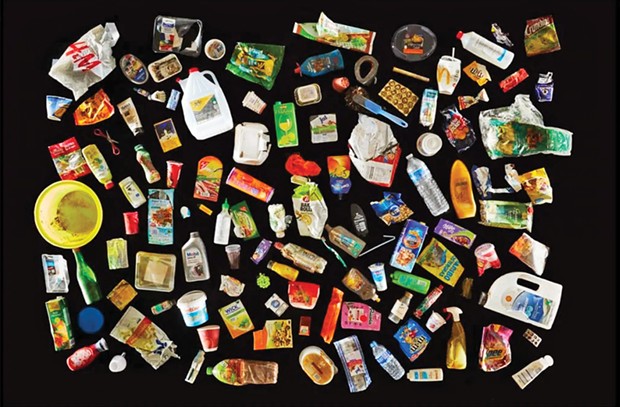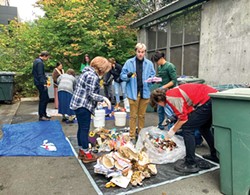Turning the Titanic
Cal Poly Humboldt recognized for leadership in addressing global plastics crisis
By Thadeus Greenson [email protected] @ThadeusGreenson[
{
"name": "Top Stories Video Pair",
"insertPoint": "7",
"component": "17087298",
"parentWrapperClass": "fdn-ads-inline-content-block",
"requiredCountToDisplay": "1"
}
]
In May of 1911, the Titanic became the biggest object ever moved by humans at the time, weighing 23,587 metric tons. We start there to put this next number into some perspective: Since plastic was introduced in the 1950s, more than 8.3 billion metric tons of it have been produced across the globe, according to a recent study out of the University of California at Santa Barbara. That's the equivalent of 351,888 Titanics.
But unlike the Titanic, which now sits decomposing 12,500 feet beneath the ocean's surface about 370 miles off the coast of Newfoundland, plastics don't break down on their own. Instead, they break up into microplastics, tiny plastic particles that have now been documented to be everywhere, including water, dirt, food, wildlife and our bodies.
Amid this backdrop — with the world continuing to produce about 300 million tons of plastic annually, according to the United Nations Environment Programme, less than 10 percent of which is recycled — little Cal Poly Humboldt recently became one of only two universities in the nation to become certified by the National Wildlife Federation as a Plastics Reduction Partner for its efforts to reduce single-use plastics on campus.
"It's a very holistic assessment of what your campus is doing, not just in how it might be operationalizing plastics reduction, but also how it's integrating plastics education into curriculum, how it's engaging the campus community to foster behavioral change," explains Morgan King, Cal Poly Humboldt's climate action analyst.
Started in 2022, Plastics Reduction Partners is the only certification program in the country that recognizes colleges and universities for reducing single-use plastics on campus. The program looks at four action areas — building awareness, supporting behavior change, implementing operational change and demonstrating institutional leadership — to offer three levels of certification: bronze, silver and green. This year, Cal Poly Humboldt and Bard College in New York received bronze-level certification, the program's lowest, becoming the first campuses in the nation to do so.
King said the certification is based not just on what Cal Poly Humboldt is currently doing, but also its roadmap for future action.
In many ways, King says the university has already plucked off much of the low-hanging fruit, noting it banned the sale of plastic water bottles, plastic bags and single-use plastic utensils in its dining commons, noting everything there is served on reusable, returnable dishware. Similarly, he said "grab-and-go" stores on campus no longer offer single-use plastic utensils and serve food on compostable plates and bowls, with compostable napkins. The university has installed close to 70 water-bottle-filling stations around campus — a crucial step given that Americans purchase about 50 billion water bottles annually, an average of 13 per month, per person, according to Grand View Research.
"There's been a big effort to build a culture of reuse on campus," King says.
But there's plenty more work to be done. King says that while the "grab-and-go" vendors on campus and catering services have moved away from plastic containers and single-use utensils, they still use individual condiment packets and offer some food packaged in "thin film wrap," which he'd like to see changed. He also notes an assessment is currently underway to look at beverage vending machines on campus and what percentage of their sales are in plastic containers versus aluminum or glass.
A potentially more impactful effort is also under way, King says, to look at the university's shipping and receiving policies.
"When someone orders an item and the package is delivered to campus, a lot of times the packaging inside that box is polystyrene or plastic wrap of some kind," he says. "We're coming up with a process where our purchasers on campus can select to receive items with packaging that is either returnable, recyclable or compostable."
But the largest area where more work is needed if Cal Poly Humboldt is to achieve its coveted green certification under the program is to integrate plastics education into curriculums across the more than 60 programs offered through its three colleges. This is already well underway in some areas, King says, noting that an introduction to wildlife conservation and management course already includes a unit on plastics and their impacts on marine life. But King says he hopes that's soon true of most — if not all — classes on campus.
"We're finding plastics in blood, so there are health impacts," he says. "So we can start going out to kinesiology and nursing and start talking about plastics in those areas, too. Plastics are just interrelated with so many other issues."
Educational efforts are extending beyond the classroom, though, as King notes work is under way to incorporate modules on the plastics crisis into campus organizations' outreach efforts. One practice he says has been particularly impactful are regular waste audits, in which a group of students go "hands-on" to sort through campus Dumpsters and document what they find to report back to facilities management.
"They gain first-hand knowledge of what's really being thrown away," King says. "We're a culture of convenience, so it's too easy to go to a store, buy a bag of chips, eat your chips and then just throw away your bag like it's no big deal. It's out of sight, out of mind. But when you're spreading [all the trash] out and everyone's seeing that 50 percent of what's in this Dumpster is food wrapping, that's crazy. Then you can start having those conversations about good alternatives."
Asked if he has any recommendations for taking Cal Poly Humboldt's approach to addressing the plastics crisis off campus, King says it's clear systemic changes are needed, voicing support for policies and ordinances that allow, promote or require the use of reusables.
"The fossil fuel industry and the plastics industry have done a great job over the years in really getting society to think it's the individual's responsibility to deal with plastics, when it's these companies that are putting them in our hands," he says. "All of us should of course do what we can to reduce plastics in our lives but we also have to do what we can to put pressure on these larger corporations to force the reduction in the manufacture of plastics and to seek alternatives to that."
As King notes, in addition to polluting our oceans, lands, food sources and bodies, plastics contribute significantly to the climate crisis, with the Center for International Environmental Law 2019 report finding if plastic production continues unabated, the industry's greenhouse gas emissions could reach 1.34 gigatons annually by 2030 — the equivalent to nearly 300 coal-fired power plants.
One more fact to help drive home the scope of the plastic crisis: This story is about 1,200 words long and in the time it takes the average reader to finish it, eight garbage trucks' worth of plastic will have entered the ocean, part of 33 billion pounds of the stuff that's dumped into the marine environment annually, according to Oceana, a multi-national nonprofit dedicated to protecting the world's oceans.
Thadeus Greenson (he/him) is the Journal's news editor. Reach him at (707) 442-1400, extension 321, or [email protected].
more from the author
-
Deputy Shoots Cutten Shooting Suspect
- Apr 25, 2024
-
Officials Weigh in on SCOTUS Case's Local Implications
- Apr 25, 2024
-
Arcata Lowers Earth Flag as Initiative Proponents Promise Appeal
- Apr 25, 2024
- More »
Latest in News
Readers also liked…
-
Through Mark Larson's Lens
A local photographer's favorite images of 2022 in Humboldt
- Jan 5, 2023
-
'To Celebrate Our Sovereignty'
Yurok Tribe to host gathering honoring 'ultimate river warrior' on the anniversary of the U.S. Supreme Court ruling that changed everything
- Jun 8, 2023

































